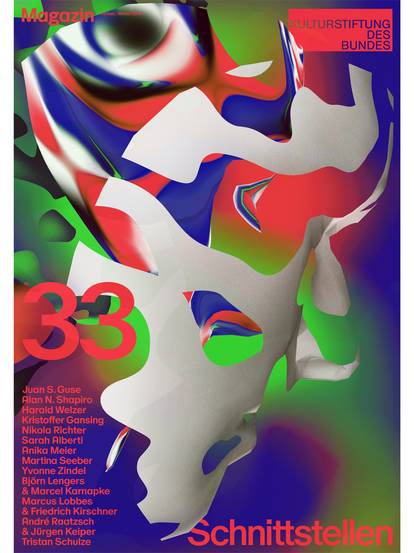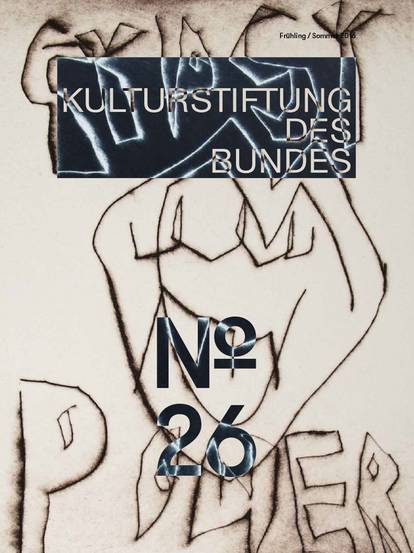Twenty years after the Holocaust, Axel Springer (1912 – 1985) devoted himself to defending his pro-Israeli stance – a matter that was very important to him. How did his views develop and what was his position toward Israel and the Jews? The Federal Cultural Foundation is funding the exhibition BILD Your Own Nation – Axel Springer and the Jews which aims to answer these questions. The exhibition focuses on the German-Israeli relationship as portrayed by the largest German tabloid and asserts that BILD played an integral role in accelerating the reconciliation process – perhaps the most extraordinary in German post-war history. Between 1933 and 1945, anti-Semitism had manifested itself in its most radical form in German politics, culminating in the systematic extermination of the Jewish people. But almost immediately after the war, the collective attitude toward Jews seemed to completely reverse itself. However, Springer’s philosemitism was viewed with acrimony by the political left of the 68er generation. In the following, the political scientist Wolfgang Kraushaar elucidates the ideological constellations of a precarious antagonism between the media mogul and the leftist camp.
by Wolfgang Kraushaar
Of all the things the left have raged against, Axel Springer, the publisher of the BILD newspaper who died a quarter century ago, certainly ranks high on the list. This is primarily due – though not solely – to his relationship to Israel, Judaism and the Jews in general. When a bomb went off at Springer’s Hamburg headquarters in May 1972, the Red Army Fraction (RAF) took responsibility for the act and demanded that the publisher cease “his propagandistic and financial support of Zionism – the imperialistic policies of Israel’s ruling class.” The statement was penned by none other than Ulrike Meinhof, the ex-journalist and celebrated iconic figure of the left.
It’s not surprising that even back then enormous energy was being spent to expose Springer as a Nazi and anti-Semite. Especially among extra-parliamentary leftists, who regarded the GDR as the model antifascist state, considerable effort was made to discover hidden connections to the Nazis in Springer’s past. In an article for the Berliner Extra-Dienst in 1970, Martin Buchholz, who would later become a cabaret artist, sardonically wrote: “Our republican Reconciliator-in-Chief, who was photographed as a strapping young Nazi in 1933 wearing a swastika armband and NSKK uniform, has been taken by a philosemitic enthusiasm ever since the Israelis showed the Germans how to deal ‘with our Arabs.’” The photo on the front page showed the 21-year-old standing together with the staff of the Bergedorfer Zeitung. He was the only one wearing a Nazi uniform. But looks can deceive.
According to all biographical accounts to date, Springer had neither been a Nazi nor an antifascist. If anything, he had been apolitical. Yet he apparently had no problem having staunch Nazis and anti-Semites in departments of his publishing house write articles and entrusting them with important tasks – as demonstrated in the cases of the former SS storm trooper leader Giselher Wirsing and the nationalistic-minded, long-standing editor-in-chief of the Welt Hans Zehrer. This might give reason for concern, but it certainly doesn’t justify misusing Springer as the basis for one’s own prejudice or making generalizations.
Federal President Gustav Heinemann once said that whoever points their finger at someone should always remember that three other fingers in their hand are pointing back at them. This idea might best characterize the controversial relationship between Axel Springer, his publishing company and its publications on one side and the political left on the other.
I.
Anti-Semitism is undoubtedly a razor-sharp word. This is especially true in Germany – more than in other countries for obvious reasons. Anyone exposed as an anti-Semite in Germany can kiss their public reputation goodbye. In order to make such a claim and maintain its validity, one requires clear and virtually irrefutable evidence. But this is exactly what’s frequently lacking. And when a dispute erupts regarding real or alleged anti-Semitism – as was recently the case within a party that had the gumption to usurp the name “The Left” for itself – a sense of awkwardness all too often pervades the discussion.
What does the Central Council of Jews in Germany base its accusation on that there’s “an almost pathological, raging hatred toward Israel” being stoked within the party? Clearly, we cannot dismiss a series of statements which support this claim. For example, the parliamentary representative of “The Left”, Inge Höger, showed up at a Palestine conference wearing a shawl depicting the Middle East without the state of Israel. And the Duisburg parliamentary faction urged those who visited its homepage to boycott Israeli products and even displayed a logo of the Star of David transforming into a swastika. But is this enough to assert that the anti-Israel and anti-Jewish position of the organization, which had formed by merging the PDS and WASG, had become “increasingly dominant within the party”? That certainly appears to be the result of a study recently conducted by one of two social scientists from the Universities of Giessen and Leipzig. But could this also merely be ammunition for the usual campaign attacks between opposing parties which try to keep disagreeable competitors at a distance? Isn’t anti-Semitism an effective means for discrediting someone or some party?
In recent years, there’s even been talk of “alarmist anti-anti-Semitism”. In other words, those who claim to fight anti-Semitism first have to invoke it. Apparently, the goal is to defend the exponents of the left. While there is certainly reason to raise alarm about right extremists, the underlying, hardly concealed message is that any such warning regarding those of the left would be inappropriate. “Anti-anti-Semitism”, therefore, is nothing more than alarmism, i.e. a chance to raise alarm for any random reason. Basically, it’s not about constructing a ubiquitous bogeyman, but rather a sideshow.
This position is not very unlike that presented by Martin Walser in his memorable acceptance speech he held in the Paulskirche in 1998 on the occasion of receiving the Peace Prize of the German Book Trade. He referred to the “Auschwitz club”, with which Germans were apparently being beaten. Ignatz Bubis, who was chairman of the Central Council of the Jews in Germany at the time, responded by calling him an “intellectual arsonist”, and although he quickly rescinded his accusation, he set off a debate regarding the maxims of a culture of remembering and commemoration in Germany.
II.
But how can one define leftist anti-Semitism and how does one recognize its virulence? What are the criteria for determining the virulence of a phenomenon such as leftist anti-Semitism? On one hand, we’re dealing with an objective structure of prejudice, and on the other, its concealment – a phenomenon not immediately recognizable, but rather indirectly and vaguely apparent. And diagnosing it is a hermeneutic task.
How can one avoid the obvious ideological pitfalls and gain a larger degree of analytical clarity? This question applies in particular to the relationship between implication and explication. Underlying this is the problem of decoupling the terminology from the phenomenon, i.e. the tendency to apply terms ambiguously and the danger of coming to sweeping conclusions.
It may seem legitimate to criticize a nation, or even the building of a nation, if such nation-building is conducted at the cost of those who already live there – in this case, the Palestinian people. The opposition and hostility toward Israel, the Jews within and outside of Israel and Judaism as a whole fit the criteria for forming conventional prejudice. Therefore, it is crucial that we gain a more precise view of the relationship between anti-Zionism and anti-Semitism. The real question we should ask is: Could anti-Zionism be a political disguise for anti-Semitism? And if so, how much anti-Semitism is concealed behind anti-Zionism? For this reason, our primary focus should be on probing this relationship more closely.
Various currents of the left have often defended themselves by pointing out – as the poet Erich Fried did in 1973 – that anti-Zionism is a legitimate point of view and should not automatically be equated with anti-Semitism. The parliamentary party “The Left”, which sees itself as anti-imperialistic, constantly emphasizes that it will not be silenced when exercising the right to fundamentally criticize the state of Israel and its roots in Zionistic ideology. And whoever claims that anti-Zionism and anti-Semitism are the same – as the Springer press had done on repeated occasions – is only intent on discriminating the left. This happens to be the same accusation levelled by “The Left”.
Is this merely a difference of opinion or perhaps rather a verbosely staged camouflage? The Dutch psychoanalyst Hans Keilson, who recently died at the age of 101, was very explicit in this point. In his opinion, the differentiation between anti-Semitism and anti-Zionism was nothing more than a linguistic feint, an argumentational trap which served to politically exploit the potential of aggression when referring to the taboo terms “Jew” or “Jewish”.
The fact that it took so long to identify the potential connection between anti-Zionism and anti-Semitism may be due to the left’s belief that their antifascist mind-set made them immune to anti-Semitic tendencies. The writer Gerhard Zwerenz was so convinced of this, that in an article for the weekly newspaper Die Zeit in 1976 he went so far as to postulate that anti-Semitism and leftist ideology would categorically cancel each other out. The journalist Henryk M. Broder was one of the first to point out this political sham. The social efficacy of anti-Semitic stereotypes is certainly not limited to any single political camp. They exist in both the right and left wings and – lest we forget – in the centre of the political spectrum. Both of our major parties (SPD and CDU) are vulnerable to such stereotyping as well.
III.
A look back in time offers a clue as to why the left of former West Germany were suspected of being anti-Semitic. We can trace it back to that historic turning point when Israel won the Six-Day War in June 1967, a war, which Springer later jokingly referred to as the six days his company published Israeli newspapers, just not in Hebrew because that would have hurt sales. After that, following June 1967, the country which had been a refuge for the victims of the Holocaust suddenly appeared as an aggressor and conqueror. As Israel’s public image changed, so did the attitude of many on the left – especially those who belonged to the Socialistic German Student Union (SDS). The pro-Israeli position of various leftist student organizations, which had numerous contacts with Israel, had sent delegations, visited kibbutzim and worked for years in Israel promoting policies of reconciliation, weakened at exactly the same time a national student movement began to crystalize following the fatal shooting of Benno Ohnesorg. This student movement was more than merely critical of Israel; at times it was fundamentally at odds with Israel’s policies and began to cement unilateral support for the Palestinians.
As an SPD-affiliated university group in the 1950s, the SDS had always been on the forefront in demanding recognition of Israel and compensation for the Jews who suffered at the hands of the Nazis. But after being thrown out of the mother party in 1961, the SDS positioned itself in the avant-garde, supporting the Palestinian struggle for national independence. There were two predominant lines of rationalistic argumentation at the heart of this reversal; first, the criticism of the especially pronounced philosemitism in the early German republic as a knee-jerk reaction to anti-Semitism, and second, the addition of Israel to the left’s classical criticism of imperialism, as it increasingly regarded Israel as a political outpost of American influence in the Middle East.
Beginning in summer 1967, the new catchwords for characterizing Israel’s policies were “aggression” and “expansion”. By abstracting the historic conditions of its origin, Zionism then became synonymous with capitalism, colonialism and imperialism. Nothing could be more unambiguous than this declaration of enmity toward the state of Israel and the Jewish citizens living there. Even at this stage, we can see the basic outlines of a repertoire, loaded with a pseudo-theoretical Marxist vocabulary, which set the stage for a poorly disguised leftist anti-Semitism. Using the protective mantle of abstract categories which seemed aligned with a programmatic critique of power, the left hoped to immunize themselves against the accusation that their anti-Zionistic stance was in fact a resurgence of anti-Semitism. What it all came down to was denying Israel the right to exist. This denial lies hidden at the centre of anti-Zionism in all its variations.
IV.
In hindsight, several events took place during the course of almost a decade – from 1967 to 1976 – which marked a fundamental change in attitude. The anti-Zionist focus comprised the basic unifying and sustaining element. Yet this focus underwent widely differing states of aggregation. It began with a general criticism of Israel in the SDS, at one time the most important organization of the radical left, evolved as an anti-Jewish attack practice within the subculture of West Berlin, manifested itself in the bombing of the Jewish Community Centre on 9 November 1969, which, although it failed, was intended as an act of terror, followed by permanent cooperative partnership between the RAF and fundamentally anti-Israeli terror groups like those operated by the Palestinians, and finally culminated in the hijacking of an airplane in Entebbe in 1976 by the Revolutionary Cells, which in their selection of Jewish hostages, came close to the eliminatory anti-Semitism practiced by the Nazis. When Axel Springer, who happened to be in Jerusalem at the time, heard the news that the hostages had been freed by an Israeli commando, he went down to the lobby of the King David Hotel at half past midnight and, dressed only in his night robe, danced for joy.
While the anti-Semitic moment continued to crystallize, the related field increasingly shrunk in size. As widespread as the criticism of Israel and an anti-Zionistic world view was, very few actually wanted to have anything to do with direct attacks on Jews or Jewish organizations. The stronger the anti-Jewish course, the more isolated its protagonists became. Because anti-Zionism did not climax into anti-Semitic forms and could not be functionalized into continued public action, this anti-Jewish tendency vanished into the newly forming, underground armed groups and increasingly manifested itself in forms of terrorism.
V.
How does one explain such a radical shift that began in summer 1967 with outspoken supporters of Israel becoming vehement opponents of Israel and advocates of the Palestinian cause, and finally came to a head in Entebbe nine years later? How is it possible that self-proclaimed antifascists could suddenly turn into convinced anti-Zionists, if not anti-Semites?
Strangely enough, two things were happening at the same time. First of all, many had begun to emphatically embrace Third World countries and by extension, glorify national, revolutionary guerrilla organizations. Secondly, many decided to focus on the Middle East conflict as the central region of crisis, and consequently identified with various Palestinian terror organizations, idealized as liberation movements.
This dual focus covered up two underlying conflicts in German society. The first was the taboo issue of the German nation and the other was the ideological confrontation between the East and West which was responsible for German division. Both issues, which should have formed the core identity of the West German left, were rooted in the Nazi past and built atop the rubble of the post-war order that followed. These issues were obviously so overwhelming that it was necessary to gloss over them by focusing instead on internationalism in general and identification with the Palestinians in particular.
The correlation between anti-imperialism and anti-Zionism is of crucial importance here. When the RAF founder Horst Mahler spoke of a “symbiosis between Zionism and imperialism” in 1972, he basically declared war on Israel. At least in this respect, it comes as no surprise that this former leftist terrorist would later become a staunch fascist. At the supranational level, it was about the domination of capital, exploitation and access to money. What was being implied was that Israel had become the incarnation of the Geldjude. The left now began regarding the Jewish state as the viceroy of the imperialistic system in the Middle East.
This view also reflects the old anti-Semitic cliché – the Jewish representative of international capital founded a state to guarantee and expand the predominance of US imperialism. There was no longer any place for the notion that the state of Israel, threatened ever since it was founded in 1948, was forced to defend itself. The topos of “Zionistic imperialism”, which remains fatally effective even today, fit the criteria of a delusional ideology. Under the protection of the Marxist-Leninist categories, the left implicitly re-invoked anti-Semitic clichés of the Nazi period and re-established a connection between the Nazi generation and the post-war generation that had long been denied.
Psychological factors play a large role in all of this. Declaring solidarity with the Palestinians offered young Germans the chance to neutralize or even completely close their eyes to the horrific crimes committed by their own country. The more warlike Israel appeared in conducting its military exercises, the easier it became (and still is) to cast the country in the role of an aggressor and suppress the memory of the Holocaust and the Jewish victims. For those born after the war, this certainly had an exonerating function. That’s also why so many people seem to equate Israel with the Nazi regime, or its military with the German Wehrmacht or even the SS. There may be a secret sense of self-justification at the centre of this enthusiasm for Palestine along the lines of: Look at the crimes our country committed – they couldn’t have been all that bad when the country that represents the victims of the Holocaust is committing crimes itself.
There are a number of defence mechanisms, studied in detail in psychoanalysis, which help the subject overcome inner conflict. One such mechanism is displacement. In its epistemological model, it is one of the functions of the ego. It allows the subject to banish unpleasant or fear-inducing processes from his or her consciousness. This consequently enables the subject to avoid dealing with the causes of the conflict and to re-establish emotional balance. The ego has a number of methods at its disposal to rid itself of feelings of guilt or shame: suppression, denial, splitting, projection and displacement.
Because the crimes committed by the preceding generation were of such mindboggling dimension – both quantitatively and qualitatively – and threatened their psychological stability, the children of that generation sought ways to transfer their feelings of guilt onto others in the process of forming their identity. Therefore, a unique opportunity presented itself to segments of the young generation when, in 1967, Israel committed an injustice against the Palestinians – in their view. This allowed them to shift some of the burden of guilt onto the representatives of the victims – guilt which their parents carried on their shoulders and which they themselves were apparently overwhelmed with.
The image of the Palestinians also offered young Germans an object of projective identification. By aligning themselves with Palestinians, they were able to guarantee their own exoneration in a way. It wasn’t for nothing that the New Left of that time, driven by an inner magnetism, continually harped on the Middle East conflict – as if there weren’t any more pressing challenges closer to home. It was for this reason that they identified with the Palestinians, especially their most aggressive organizations, and concluded that the Israelis were the cause of all their problems. In this way, it was possible to transform unresolved psychological problems into a supposedly political project. Viewed from this perspective, the repeated call for peace in the Middle East could actually be more about the German activists’ desire for inner peace.
VI.
Axel Springer was – and still is, to some extent – regarded by the left as something of an archenemy. He seemed to represent all that was negative about the establishment with its completely intact canon of 1950s’ values and an extremely resilient ‘perfect world’ ideology. All the ideals, which the West German radical left rejected, were bundled in Axel Springer: anti-totalitarian, pro-Israel, pro-American, supporter of German reunification and the defender of the capitalistic economic system. The left had argued that toppling Springer’s media imperium was key to preventing the further “manipulation” of the wage-dependent masses and to turning them instead into revolutionary-minded agitators. The left regarded this powerful, yet rather mild-mannered man as standing between the political apathy of the masses and their own class-war mobilization. And this is why he was so reviled.
Yet despite all their differences, there are several things which, oddly enough, linked Springer with the radical left. For example, until 1967 the SDS had a philosemitic orientation, and it was exactly at that time Axel Springer made it a principle of his own. It was as if the baton had been passed from the left to the right hand. And with regard to his opposition to the SED (Socialist Unity Party of Germany), Springer could hardly outdo Rudi Dutschke, the uncontested spokesperson of the APO who had escaped the GDR shortly before the Berlin Wall was erected. If Springer had known that Dutschke was such an avid supporter of German reunification, it’s not entirely inconceivable that he and Dutschke could have sat down and talked, and things might have turned out differently. Springer’s son, who committed suicide on the day of Dutschke’s funeral, had even financially supported Dutschke’s wife and children for a time. So despite so much antagonism between the factions, there seems to be a tragic dimension to the story that binds them beneath the surface. And perhaps the same goes for the relationship to Israel and the Jews.

![[Translate to English:] Magazine 38](/fileadmin/_processed_/f/1/csm_Magazin38_Cover-Vorschau_921x1230_689f428dc3.jpg)
![[Translate to English:] Magazine 37](/fileadmin/_processed_/b/c/csm_Mag37_Cover-Vorschau_921x1230_b5129fdb2a.jpg)
![[Translate to English:] Magazine 36](/fileadmin/_processed_/2/a/csm_Cover_Magazin36__issuu_2f3cef97bb.jpg)





![[Translate to English:] Magazine 30](/fileadmin/_processed_/c/b/csm_magazin30_vorschau_9005f773d3.jpg)














